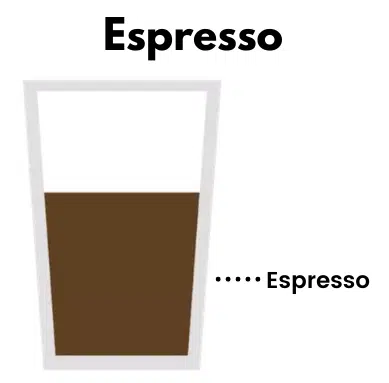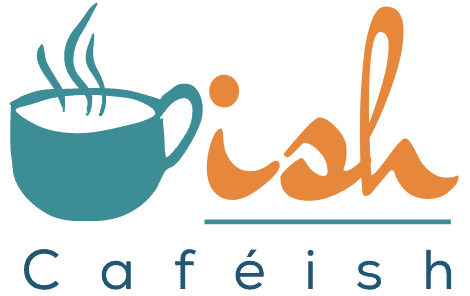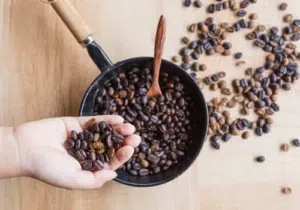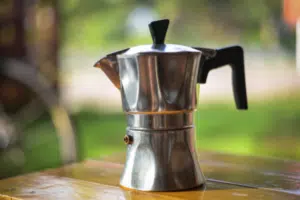Latte vs Espresso vs Cappuccino: Taste, Ingredients, Strength & More
Disclosure: This post contains affiliate links and I may earn a small commission (at no extra cost to you) if you click through and make a purchase. Thanks in advance – I really appreciate it!
If you’re like most of my friends, who’ve found themselves staring down the list of impressively named coffee beverages at their local coffee shops and felt totally confused by the end of it. I have some good news for you. Today is your lucky day as in this article I will cover all the major differences between a latte, espresso, and a cappuccino.
Latte vs Espresso vs Cappuccino
Espresso is a concentrated form of coffee served in small, strong shots and is the base for latte and cappuccino. Cappuccino is made with equal parts of espresso, steamed milk, and foamed milk. Latte, on the other hand, is made with 1/6 espresso, 4/6 steamed milk, and 1/6 foamed milk.
Key Takeaways:
- Espresso is a concentrated form of coffee served in small, strong shots. It’s made from the same beans as coffee but is stronger.
- Latte is made when espresso is combined with steamed milk to create a creamy smooth coffee beverage with a delicate espresso flavor.
- Cappuccino is simply espresso topped with steamed milk and milk foam.
- The espresso being a concentrated form of coffee has a very strong, robust, and rich taste.
- Latte, on the other hand, has several ounces of steamed milk which gives it a rich, creamy taste with a more subtle espresso flavor.
- Espresso is a dark, dense, thick concentrated form of coffee so it is without a doubt the strongest in flavor and taste.
In the rest of this article, I will compare these coffee drinks in terms of their method of preparation, ingredients, caffeine content, taste, calories, and more. So if you’re interested in knowing more about how you can distinguish a latte from a cappuccino and an espresso, then stick around till the end. It will be worth it.
Latte, Espresso, Cappuccino; What’s the Difference?
Like most espresso-based beverages, the main differences between a latte and a cappuccino come down to the ratios within. A latte contains much more steamed milk than espresso (2 to 1), whereas a cappuccino contains equal amounts of espresso, steamed milk, and microfoam.

- Ingredients: 1/6 espresso, 4/6 steamed milk, 1/6 foamed milk.
- Taste: Mild, milky, creamy.
- Strength: Light.
- Caffeine: Depends on the number of shots of espresso. (1 shot of espresso = 68mg caffeine)

- Ingredients: Coffee & water.
- Taste: Bold, rich, thick & creamy.
- Strength: Very strong.
- Caffeine: 1 shot of espresso = 68mg caffeine.

- Ingredients: 1/3 espresso, 1/3 steamed milk, 1/3 foamed milk.
- Taste: Foamy, stronger coffee flavor.
- Strength: Medium-Strong.
- Caffeine: Depends on the number of shots of espresso. (1 shot of espresso = 68mg caffeine)
What is Espresso?
Espresso is a concentrated form of coffee served in small, strong shots. It’s made from the same beans as coffee but is stronger.
It’s rich, robust, concentrated and frequently used as the base for familiar coffeehouse beverages, such as cappuccinos and lattes.
The best espresso can only be made with an espresso machine.
Espresso machines pressurize and shoot near-boiling water through finely-ground coffee beans packed into cakes.
This method of making espresso gives you a complex, aromatic, and caffeine-packed shot of coffee in under thirty seconds.
What is Latte?
A latte begins with 1-2 shots of espresso coffee as its base. Then, espresso is combined with steamed milk to create a creamy smooth coffee beverage with a delicate espresso flavor.
The typical shot of espresso to steamed milk ratio is 1-to-2. To finish up, the latte is topped with a thin layer of milk foam. In its simplest terms, a latte is a coffee created by combining espresso with steamed milk and milk foam.
Latte has a very light coffee taste and a creamy texture thanks to the addition of steamed milk.
What is Cappuccino?
Cappuccino is one of the most popular coffee drinks around the world, it is simply espresso topped with steamed milk and milk foam.
A cappuccino starts with a bottom layer of one or two shots of espresso. A layer of steamed milk is added on top, followed by a thick and airy layer of foam that gives the drink a luxurious velvety texture.
All over the world, the standard cappuccino is made with coffee, steamed milk, and foam in a ratio of 1:1:1.
A cappuccino boasts a much stronger espresso flavor than a latte due to having less milk and more foam than a latte.
Latte vs Espresso vs Cappuccino: Taste
The mighty espresso being a concentrated form of coffee has a very strong, robust, and rich taste. Latte, on the other hand, has several ounces of steamed milk which gives it a rich, creamy taste with a more subtle espresso flavor.
Some hardcore espresso enthusiasts may actually find latte’s taste quite similar to sweetened milk.
The natural sweetness of added steamed milk gives the latte a creamy flavor and a very mild taste of coffee.
Cappuccino, as I said before, is made with equal parts of espresso, steamed milk, and microfoam. Cappuccino has much less milk and more foam as compared to latte so it has a stronger taste of espresso.
Also, more amount of foam on top of a cappuccino gives it a smooth, foamy velvety texture as compared to the creamy texture of latte and thicker texture of an espresso.
Caffeine Content in Espresso, Latte & Cappuccino
One shot of espresso has 68mg of caffeine. The amount of caffeine in a latte or a cappuccino will depend on the number of shots of espresso used to make that beverage. A cappuccino and a latte typically have the same amount of caffeine (68mg), because they are both made with 1 shot of espresso.
Adding more shots of espresso will increase the caffeine content.
So the exact amount of caffeine depends on whether it’s a single-shot, double-shot, or triple-shot latte or a cappuccino, and what kind of beans you’re using to make the espresso.
So next time when you order a latte or a cappuccino, don’t forget to specify how many shots you want in your drink.
Which is stronger, Latte, Espresso, or Cappuccino?
Espresso is a dark, dense, thick concentrated form of coffee so it is without a doubt the strongest in flavor and taste.
A Cappuccino, although has milk, it still has a much stronger coffee taste. The cappuccino is equal parts espresso, steamed milk, and milk foam.
A latte is one part espresso to at least three parts of steamed milk. Some coffee houses use as much as eight to 15 parts milk per one part espresso. A light layer of foam may or may not be added on top.
Since the caffeine content is the same in all three drinks, the strength here is simply a measure of how much you taste the bite of the espresso in the beverage.
In other words, thanks to the presence of a lot more steamed milk in a latte, it has the lightest and most mellow taste among all three coffee drinks.
Latte vs Espresso vs Cappuccino: Calories
A standard shot of espresso without any additives is a very low-calorie drink, less than 10 calories.
When it comes to a latte and a cappuccino, a cappuccino will likely have fewer calories because it has less milk. A typical 12-ounce cappuccino is made with whole milk and has 130 calories, while a 12-ounce latte has about 210 calories because it has more milk added to it.
Non-fat milk or alternative milk like almond, coconut, or oat milk are also great options for these drinks.
Which one is healthier?
Well if you’re measuring the ‘healthiness’ of a coffee by the number of calories present in it (more calories = less healthy) then espresso is the healthiest among the three as it has the least amount of calories.
That said, there’s actually nothing unhealthy about milk if consumed in moderate quantity such as in a cappuccino or a latte.
Still, if calories and fat content are the primary concern, then a latte could be considered the less ‘healthy’ option when compared to a cappuccino, given the quantity of milk involved.
How To Make Espresso At Home
Grind the coffee: Use espresso roast coffee, about 9 grams for a single espresso shot and. Grind the coffee until it’s very finely ground.
Pack and tamp the coffee grounds: Add the coffee grounds to the espresso basket (portafilter) until it’s slightly heaping over the top. Use the tamper to press the grounds evenly into the portafilter, pressing very firmly until it is fully compressed.
Pull the shot: Place the portafilter in the espresso machine and press the button to pull the shot. A well-pulled espresso shot will last around 25 to 30 seconds and have a deep espresso flavor with a nice foamy crema.
That’s it! Your delicious shot of espresso is ready to be enjoyed.
Here’s a simple video to help you further understand how a shot of espresso is made.
How To Make Latte At Home
Pull a shot of espresso. Make a shot of espresso and pour it into a 12-ounce mug. Set aside.
Froth the milk. Pour the milk into a frothing pitcher large enough to hold at least 12 ounces and submerge the steam wand into it and start frothing the milk. The bubbles should be tiny and uniform.
Stop the frother when the milk reaches 140ºF to 150ºF
Pour the frothed milk. Gently pour the frothed milk over the espresso in a slow narrow stream. There should be up to a three-quarter-inch layer of foam on top of the latte.
You can also follow the recipe for making latte as shown in this video.
How To Make Cappuccino
Foam the milk. Foam and texture the required quantity of milk – Remember! We want more foam than steamed milk.
Gently swirl the milk to release any large air bubbles – tap the milk jug against a counter to remove any stubborn bubbles.
Make espresso. Brew a single or double espresso (as per taste or order) directly into your serving cup.
Add milk to espresso. Pour the milk over the espresso from a low height for a smooth drink.
Below is a video with easy-to-follow steps to make a delicious cup of cappuccino at home.
Conclusion
So now you’ve got the full scope – all the major differences between an espresso, latte, and a cappuccino. Go ahead, confidently enter any coffee shop and look the barista in the eye and order your favorite drink from that daunting menu.
If you would like to know the differences between a few other coffee drinks then you can read any or all of the articles I have listed below.

Amit Gupta
Hi, my name is Amit Gupta, and I am the owner and contributor at Cafeish. My obsession with coffee started when I received my first French press as a gift almost ten years ago. Since then, my love of coffee – and the number of coffee gadgets I own – has grown considerably.
Most Popular
ABOUT US
We are a team of coffee affcianados with experience and expertise in making world renowned coffee. In fact, preparing the best coffee ever with a fluffy top reminds us of magic, with secrets of how to achieve each particular effect. Making coffee is not our only hobby, we always keep our ears open as to what’s happening around and what scientists and manufacturers produce for consumers. It’s not an easy task to do – it’s rather time consuming. Hence, Caféish website was launched.
LEGAL DISCLAIMER
Caféish is a participant in the Amazon Services LLC Associates Program, an affiliate advertising program designed to provide a means for sites to earn advertising fees by advertising and linking to Amazon.com. Caféish also participates in affiliate programs with Clickbank and other sites. Caféish is compensated for referring traffic and business to these companies.




